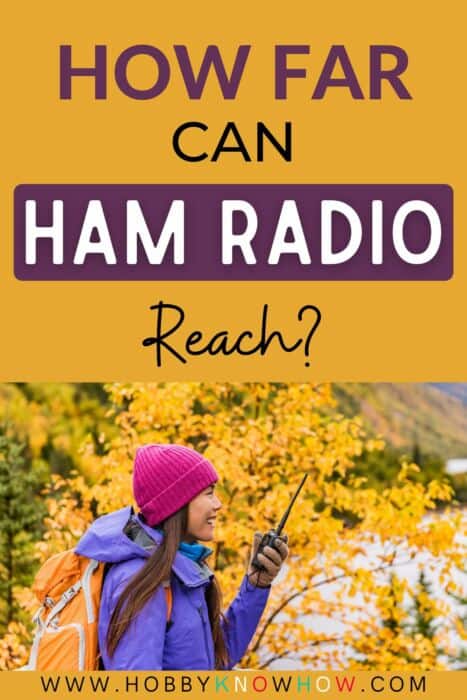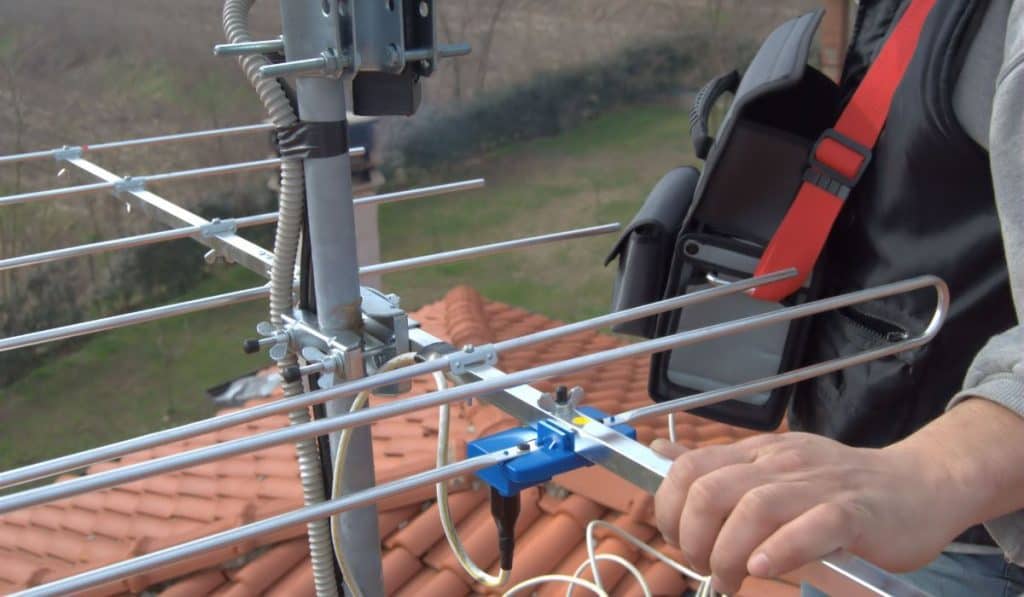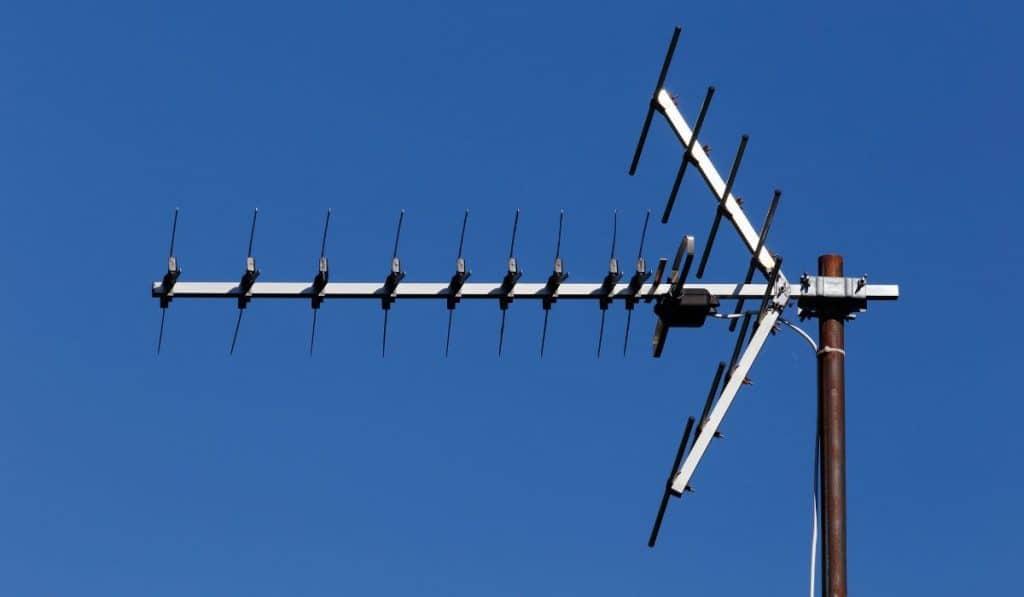Ham radio can reach from as close as 1 or 2 miles with handheld ham radio and up to 13,000 miles which is about half the Earth’s circumference with more sophisticated HF radio setups. Several factors can affect and limit how far you can transmit with an amateur radio from obstructions such as the curvature of the earth, the power of the transmitter, the frequency band, the sensitivity of the receiver, and many more.
Often, you will see ham radio manufacturers give you range figures such as 25 miles and such, but these are often abstract numbers that are taken under perfect conditions and not at all practical in the real-world setting.
They fail to take into account that there are a lot of limiting factors. You should not take the values they give at face value but rather use the range rating as the highest possible distance you can transmit with the said device.
But to understand why exactly this is the case, it is important to look at the main factors that can affect how far ham radio can reach.
These factors are:
- The type of radio transmission (amateur radio band)
- Physical and atmospheric obstacles
- Type of antenna and its power output
- How high your antenna is from the ground
The type of ham radio transmission
This is also known as the ham bands or the frequency ranges that amateur radio operators use that we also go through in our complete guide to getting into amateur radio. These bands are categorized into three main groups which are:
- High Frequency (HF) bands
- Very High Frequency (VHF) bands
- Ultra-High Frequency (UHF) bands
| Type of transmission | Transmission Band | Frequency range (MHz) | Average wavelength (λ) | Mode of propagation |
| Ultra-high frequencies | 70 cm UHF | 430 to 440 | 70 centimeters | Direct wave/Line of sight Tropospheric ducting/troposcatter |
| Very high frequencies | 2-meter VHF | 144 to 148 | 2 meters | Direct wave Tropospheric ducting/troposcatter Meteor Scatter Moon reflection |
| Very high frequencies | 6-meter VHF | 50 to 54 | 6 meters | Troposcatter Meteor scatter Moon reflection Infrequent ionospheric refraction |
| High frequencies | 10-meter HF | 28.0 to 229.70 | 10 meters | Ionospheric refraction/Skywave Troposcatter |
| High frequencies | 12-meter HF | 24.890 to 24.990 | 12 meters | Ionospheric refraction/Skywave Troposcatter |
| High frequencies | 15-meter HF | 21.0 to 21.450 | 15 meters | Ionospheric refraction/Skywave Troposcatter |
| High frequencies | 17-meter HF | 18.068 to 18.168 | 17 meters | Ionospheric refraction/Skywave |
| High frequencies | 20-meter HF | 14.0 to 14.350 | 20 meters | Ionospheric refraction/Skywave |
| High frequencies | 30-meter HF | 10.1 to 10.15 | 30 meters | Ionospheric refraction/Skywave |
| High frequencies | 40-meter HF | 7.0 to 7.3 | 40 meters | Ionospheric refraction/Skywave |
| High frequencies | 80-meter HF | 3.5 to 4.0 | 80 meters | Ionospheric refraction/Skywave |
High frequencies
HF bands have the highest range of all the three ham radio band categories and can be used for communication halfway around the world.
This is because high frequencies can bounce off the ionosphere (charged zone of the earth’s atmosphere) at an angle.
However, different HF bands will have different ranges depending on the time of day you are broadcasting. For example, you can transmit farther on the 20-meter band at night than during the day as the ionosphere’s reflectivity decreases during the day.
As the ham waves are reflected to and from the ionosphere, they slowly lose their energy, and eventually, the signal becomes too weak (low signal to noise ratio) to be received on the other end.
VHF and UHF bands
These bands mainly rely on line-of-sight propagation to reach their recipients which is why repeaters are needed for long-distance propagation.

However, they can also be propagated through troposcatter/tropospheric duction with the help of large and high-gain antennas which increases the setup cost.
VHF bands can travel farther than UHF bands but are more sensitive to reflections by obstacles such as buildings, vehicles and are thus not well suited for cities but can propagate better in outdoor settings such as forests.
Meanwhile, UHF bands have the shortest range but can penetrate non-conductive materials such as wood better and are thus better at transmitting in areas with a lot of buildings and so on, over short distances.
It is also important to remember that the farther the signals travel, the weaker they become, and will eventually reach a point where they are weaker than the background noise and cannot be recovered.
The internet can also greatly improve your range from a few miles to hundreds of miles in what is known as EchoLink (Voice over IP) or Internet Radio Linking Project (IRLP). This is where local repeaters are linked with other repeaters over an internet protocol.
All you need to do is use your transceiver to connect to your local repeater by typing in a code and typing in another code for the linked repeater where you intend to transmit to.
This greatly improves how far you can broadcast over ham radio for endless possibilities.

Physical and atmospheric obstacles
Obstacles such as buildings, trees, vehicles, hills, atmospheric moisture, snow, and so on can come in the way of your amateur radio transmissions.
Different obstacles cause different ham bands to react differently. Not all obstacles will be bad for your transmission but most of them will limit how far you can transmit by absorbing the radio waves and converting them into heat.
Other obstacles will reflect the radio waves and can cause interference if you are transmitting over shorter distances.
What’s more; some lower frequency bands can get around obstacles in what is known as diffraction. For diffraction to occur, the wavelength of the transmitting frequency needs to be higher than the dimension of the impediment.
For example, if a building is 10 meters wide and you are broadcasting over the 20-meter band, the amateur waves should hit the building and diffract to get around it and travel to the recipient.
Type of antenna and signal strength
The type of antenna you decide to use for your ham transmission also has a direct effect on how far your broadcast can reach as it affects the signal strength or gain level.
There two main types of antenna used by amateur radio operators and these are:
- Dipole antennas – Contains two conductors that generate electromagnetic waves. Traditional TV antennas are a good example of dipole antennas.
- Monopole antennas – Whip and mast antennas are an example of monopole antennas that use a single conductor that is usually connected to a ground plane to improve the quality of the transmissions.
These antennas are widely used by hams to broadcast since they are omnidirectional and can boost the signal strength (increase gain) by redirecting some of the signal’s energy.
The signal strength then reduces the farther they get from the transmitting antenna. Every time the distance the ham signals have to travel is doubled, the signal strength (wattage) is reduced by four times.
Losses can also occur between the transmitter and the antenna. Unless you are using a handheld transceiver, you will need a cable to connect the transmitter to the antenna which is another point where the signals can lose their strength, especially if they are lengthy and poorly built.
Any loss in the signal strength can greatly affect how far you can reach with your ham radio.

Height of the antenna
For every transmission, there needs to be an antenna. HF bands need the largest antenna due to their large wavelength while UHF bands need the smallest antennas since their wavelengths are significantly smaller.
With that in mind, you need to know that the antenna height has a direct influence on the range of the amateur radio waves.
The higher the antenna, the better the range taking into account any losses that may occur due to the connecting cable.
Higher antennas are needed to overcome the curvature of the earth and other obstructions that may cause interference. However, there are regulatory limits to how high you can have your antenna which also depends on the type of license you hold.
To better understand how the height of your antenna can affect range due to the earth’s curvature, we have to introduce a formula which is:
D = √H x 1.415
D is the range/the transmission distance in miles, H is the height of your antenna in feet while 1.415 is the constants (C) that is calculated in reference to the earth curvature.
As you can see, the range is directly proportional to the height, and, therefore, increasing the height of your antenna increases the range as it increases the clearance from the Fresnel zone.
So, if you are six feet tall and are holding a handheld transceiver with a whip antenna that is about 3 feet long, the height of the antenna off the ground will be 9 feet. Using the above formula, you should have a range of about 4.245 miles, in theory, without taking into account the height of the receiver’s antenna.
However, this range can only be reached in perfect conditions that are not practical in the real world and depending on the terrain and other limiting factors that may cause RF interference, the range could be slashed by half or even more.
But before you set up your antenna to the maximum possible height, ensure that you are following all regulations on antenna height.
In Conclusion
As you can see, no one can straight up tell you how far you can broadcast using amateur radio since it depends on a variety of factors.
So, depending on where you are transmitting from, the atmospheric conditions, time of day, and the kind of equipment you use or plan to use, the range could vary greatly from a few miles to several thousand miles.




